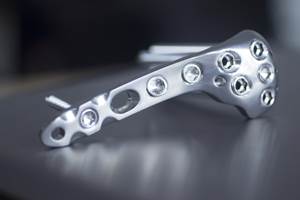Filmic/Chemical Cleanliness Becoming Just as Important as Particulate Cleanliness
Glued, sealed, welded and coated parts require clean, adherent surfaces in addition to specified particulate cleanliness. This article offers advice on how to clean these parts effectively.
Q: Meeting filmic and chemical cleanliness requirements in Europe is becoming increasingly more important. How can these requirements be met effectively?
A: In many industries, the focus after machining used to be on the removal of particulate soil, not filmic/chemical contaminants such as residues from metalworking fluids and fingerprints. However, this is changing because hardware is being replaced by adhesives or welded parts. Instead of high quality materials, more cost-effective materials with surface coatings are being used. Regardless of the surface to clean, processes such as gluing, sealing, welding and coating require clean, adherent surfaces in addition to the specified particulate cleanliness.
Wet chemical cleaning technologies are usually used to clean these surfaces. However, before selecting an appropriate solution, the focus should be on the metalworking fluid that must be removed to determine a part’s cleanability and whether a mixture of the fluids can cause problems in the cleaning process. Substances that are difficult to remove should be eliminated by optimizing the production process and limiting the amount of fluids used. Keep in mind that fluid changes as well as changes in their formulations can affect cleanability.
In addition to the type of soil, the amount is an important consideration. Contrary to monitoring the achieved cleanliness, measuring the amount of contamination prior to cleaning is important. Knowing the ratio of metalworking fluids used versus the number of parts machined offers a rough idea of how dirty the parts are.
To ensure that wet chemical cleaning is effective, choosing the right cleaning agent, cleaning temperature, cleaning time, capacity and type of cleaning process (ultrasound, spraying system, rinsing cycles and so on) is critical. To meet stringent requirements for particulate and filmic/chemical cleanliness, systems are available that enable solvent- and water-based cleaning steps in a single chamber as well as machines that combine wet chemical processes with low-pressure plasma cleaning.

Knowing the ratio of metalworking fluids used versus the number of parts machined offers a rough idea of how dirty the parts are.
Knowing the material; size and geometry of the components; type and quantity of contamination; throughput requirements and cleaning specifications is also important in order to see the best possible cleaning results.
With the increasing demands on filmic/chemical cleanliness, greater importance is being placed on the quality and/or cleanliness of the cleaning and rinsing baths, especially in aqueous cleaning processes. Removed substances must not be able to settle again on the components. Well-demulsifying cleaners, chemically clean rinsing baths, reliably working oil separators and effective media preparation are essential. In addition, sensor technology is used directly in the cleaning systems, which enables monitoring the bath quality continuously to automatically replenish cleaner components and to indicate necessary bath changes.
Even though many cleaning jobs can be solved with wet chemical processes, some cannot, such as cleaning during assembly and selective cleaning of functional areas prior to bonding or welding. For these applications, technologies such as laser cleaning, atmospheric pressure plasma or CO2 snow jet cleaning have been established in recent years.
With laser technology, cleaning is achieved by evaporating the layer of soil. The surface can also be roughened or textured- as needed by changing the laser parameters accordingly.
Cleaning with atmospheric pressure plasma removes thin residual organic contamination. During the plasma process, the surfaces are simultaneously cleaned and activated. The latter is based on the physical and chemical reaction of the process, which leads to an increase in surface energy.
CO2 snow blasting, given its different active principles and easy control of the particle jet, is useful for the selective removal of both particulate and film-type contamination. Another advantage of these dry cleaning technologies is that they can be easily automated and integrated into interlinked production lines.
About the Author
Doris Schulz
Schulz is the owner of Schulz.Presse.Text, a public relations agency in Stuttgart, Germany. Schulz has been working with clients in the cleaning industry, as well as the parts2clean trade show, for more than 20 years. She is also working as a freelance journalist. Contact: doris.schulz@pressetextschulz.de
Related Content
Cool Clean’s Omega 1500 Provides Powerful, Portable Cleaning
PMTS 2023: By selecting the appropriate nozzle and making the necessary propellant pressure and temperature adjustments, the Omega 1500 can clean to a variety of surface cleanliness levels.
Read MoreKyzen Solvents Provide Ease of Cleaning for Medical Parts
The Metalnox line of solvent products are designed to improve reliability and increase the ease of cleaning in vacuum and vapor degreasing processes.
Read MoreMeeting Stringent Cleaning Goals With Modular Ultrasonic System
A knee implant manufacturer implements an advanced cleaning system that meets its tight cleaning requirements, including documenting, validating and tracing the entire cleaning process.
Read MoreEnvironmentally Friendly Model 550 Versatile Parts Washer
PMTS 2023: This washer is useful in a variety of applications, including tool rooms, maintenance operations, low production and precision cleaning.
Read MoreRead Next
Seeing Automated Workpiece Measurement in Real Time
User-friendly inspection software for CNC machining centers was shown at IMTS 2024 monitoring measurements between and after machining while performing SPC based on recorded measurement values.
Read More5 Aspects of PMTS I Appreciate
The three-day edition of the 2025 Precision Machining Technology Show kicks off at the start of April. I’ll be there, and here are some reasons why.
Read MoreA Tooling Workshop Worth a Visit
Marubeni Citizen-Cincom’s tooling and accessory workshop offers a chance to learn more about ancillary devices that can boost machining efficiency and capability.
Read More









.jpg;maxWidth=300;quality=90)














